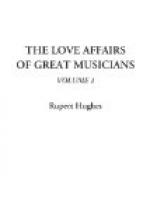The first meeting of Chopin and Sand was a curious proof of the value of presentiments, and should interest those who have such things and believe them. Chopin, according to Karasovski, went to the salon of the Countess de Custine. As he climbed the stairs he fancied that he was followed by a shadow odorous of violets; he wanted to turn back, but resisted the superstitious thrill. Those violets were the perfumery of George Sand. She snared him first with violet-water, and thereafter surrounded him with her multitudinous wreaths of tobacco—though he neither made nor liked smoke. She, however, puffed voluminously at cigarettes, and even, according to Von Lenz, at long black cigars—as did Liszt’s princess.
Other accounts are given of the first meeting, and Liszt claims the credit for arranging it all at her request, in spite of Chopin’s desire not to meet her. But, be that as it may, he came, he saw, and she conquered. The two were alike chiefly in their versatility as lovers.
Chopin’s first loves were his family, on whom he doted with Polish fervour. George Sand once exclaimed that his mother was his only love. She was a Polish woman whose name was Krzyzanovska—a good name to change for the shorter tinkle of “Chopin.” It was from her that Chopin took that deep-burning patriotism which characterised him and gave his music a national tinge. And at that time Polish patriotism was bound to be all one elegy. But Chopin’s father was a Frenchman, and when finally the composer reached Paris, he found himself instantly at home, and the darling of the salons. How different this feeling was from the loneliness and disgust that Paris filled Mozart’s soul withal!
As we found Mozart’s first serious wound in the heart coming from a public singer, so Chopin (unless we except his pupil, the Princess Elisa Radziwill) seems to have been caught very young by Constantia Gladkovska. She made a great success at Warsaw in the year which was Chopin’s twentieth. He had previously indulged in a mild flirtation with a pretty little pianist and composer, Leopoldine Blahetka, but in her case he seems less to have loved than to have graciously permitted himself to be loved. When he fell under the witchery of Gladkovska, however, he was genuinely pierced to the heart, and his letters are as full of vague morose yearning as his Preludes. He left Warsaw for Vienna, but the memory of her pursued him. She had sung at his farewell concert in Warsaw, and made a ravishing success as a picture and as a singer. In Vienna he longed for her so deeply that he went about wearing the black velvet mantle of gloom which was so effective on the musicians and poets of that day.




